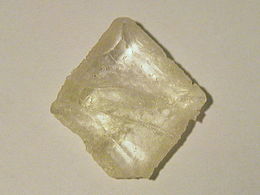| Kainite | |
|---|---|
 | |
| General | |
| Category | Sulfate minerals |
| Formula (repeating unit) | KMg(SO4)Cl·3H2O |
| Strunz classification | 7.DF.10 |
| Crystal system | Monoclinic |
| Crystal class | Prismatic (2/m) (same H-M symbol) |
| Space group | C2/m |
| Unit cell | a = 19.72, b = 16.23 c = 9.53 [Å]; β = 94.92°; Z = 16 |
| Identification | |
| Color | Colorless; yellow, brownish, greyish-green, red, violet, blue |
| Crystal habit | Crystal aggregates, fibrous, massive |
| Cleavage | {001}, perfect |
| Fracture | Splintery |
| Tenacity | Brittle |
| Mohs scale hardness | 2.5–3 |
| Luster | Vitreous |
| Streak | White |
| Diaphaneity | Transparent |
| Specific gravity | 2.15 |
| Optical properties | Biaxial (−) |
| Refractive index | nα = 1.494 nβ = 1.505 nγ = 1.516 |
| Birefringence | δ = 0.022 |
| Pleochroism | Visible: X = violet, Y = blue, Z = yellowish |
| 2V angle | Measured: 90° |
| Dispersion | Weak |
| References | [1][2][3] |
Kainite (/ˈkaɪnaɪt/ or /ˈkeɪnaɪt/)[4] (KMg(SO4)Cl·3H2O) is an evaporite mineral in the class of "Sulfates (selenates, etc.) with additional anions, with H2O" according to the Nickel–Strunz classification. It is a hydrated potassium-magnesium sulfate-chloride, naturally occurring in irregular granular masses or as crystalline coatings in cavities or fissures. This mineral is dull and soft, and is colored white, yellowish, grey, reddish, or blue to violet. Its name is derived from Greek καινος [kainos] ("(hitherto) unknown"), as it was the first mineral discovered that contained both sulfate and chloride as anions. Kainite forms monoclinic crystals.

- ^ The Handbook of Mineralogy
- ^ Mindat.org
- ^ Webmineral.com
- ^ "kainite". Oxford English Dictionary (Online ed.). Oxford University Press. (Subscription or participating institution membership required.)